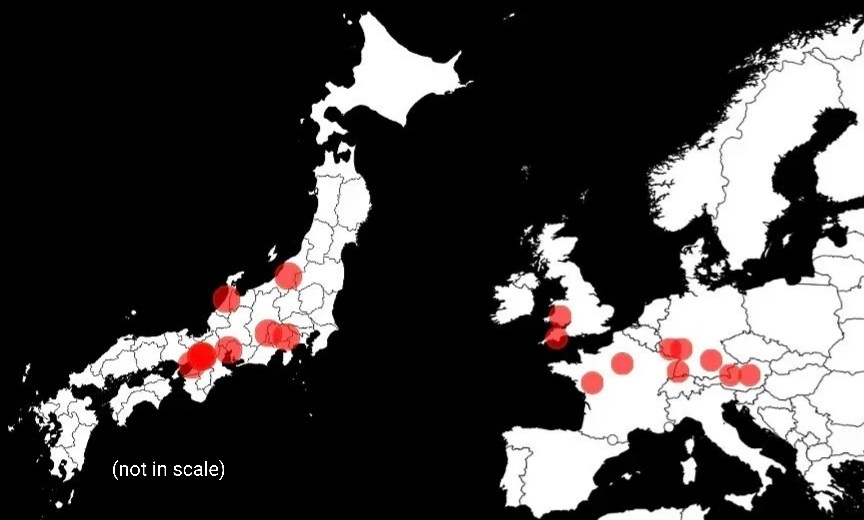|
Pivovar Krakonoš
Pivovar Krakonoš is one of the oldest breweries in the Czech Republic. Founded in 1582 and located in Trutnov town, the annual production of light and dark beers exceeds 100,000 hectoliters. In 1974, future Czech president Václav Havel worked here, and was inspired to write a theater play, ''Audience'', whose story is situated in the brewery. See also *List of oldest companies The oldest companies in the world are the brands and companies which remain operating (either in whole or in part) since inception, excluding associations and List of oldest universities in continuous operation, educational, government, or relig ... References ''Article contains translated text from Pivovar Trutnov on the Czech Wikipedia retrieved on 25 February 2017.'' External links * Breweries in the Czech Republic Companies established in the 16th century 16th-century establishments in Bohemia Trutnov 1582 establishments in the Habsburg monarchy {{CzechRepublic-company-stub ... [...More Info...] [...Related Items...] OR: [Wikipedia] [Google] [Baidu] |
Trutnov
Trutnov (; ) is a town in the Hradec Králové Region of the Czech Republic. It has about 30,000 inhabitants. The historic town centre is well preserved and is protected as an urban monument zone. Administrative division Trutnov consists of 21 municipal parts (in brackets population according to the 2021 census): *Dolní Předměstí (2,491) *Dolní Staré Město (566) *Horní Předměstí (3,936) *Horní Staré Město (7,312) *Kryblice (2,945) *Střední Předměstí (5,915) *Vnitřní Město (1,187) *Adamov (74) *Babí (124) *Bohuslavice (122) *Bojiště (288) *Lhota (155) *Libeč (303) *Nový Rokytník (53) *Oblanov (131) *Poříčí (1,946) *Starý Rokytník (375) *Střítež (98) *Studenec (84) *Volanov (546) *Voletiny (403) The urban core is formed by Dolní Předměstí, Dolní Staré Město, Horní Předměstí, Horní Staré Město, Kryblice, Střední Předměstí and Vnitřní Město. Etymology Both the German name ''Trautenau'' and the Czech name ''Trutnov'' are d ... [...More Info...] [...Related Items...] OR: [Wikipedia] [Google] [Baidu] |
Czech Republic
The Czech Republic, also known as Czechia, and historically known as Bohemia, is a landlocked country in Central Europe. The country is bordered by Austria to the south, Germany to the west, Poland to the northeast, and Slovakia to the southeast. The Czech Republic has a hilly landscape that covers an area of with a mostly temperate Humid continental climate, continental and oceanic climate. The capital and largest city is Prague; other major cities and urban areas include Brno, Ostrava, Plzeň and Liberec. The Duchy of Bohemia was founded in the late 9th century under Great Moravia. It was formally recognized as an Imperial Estate of the Holy Roman Empire in 1002 and became Kingdom of Bohemia, a kingdom in 1198. Following the Battle of Mohács in 1526, all of the Lands of the Bohemian Crown were gradually integrated into the Habsburg monarchy. Nearly a hundred years later, the Protestantism, Protestant Bohemian Revolt led to the Thirty Years' War. After the Battle of White ... [...More Info...] [...Related Items...] OR: [Wikipedia] [Google] [Baidu] |
Brewery
A brewery or brewing company is a business that makes and sells beer. The place at which beer is commercially made is either called a brewery or a beerhouse, where distinct sets of brewing equipment are called plant. The commercial brewing of beer has taken place since at least 2500 BC; in ancient Mesopotamia, brewers derived social sanction and divine protection from the goddess Ninkasi. Brewing was initially a cottage industry, with production taking place at home; by the ninth century, monasteries and farms would produce beer on a larger scale, selling the excess; and by the eleventh and twelfth centuries larger, dedicated breweries with eight to ten workers were being built. The diversity of size in breweries is matched by the diversity of processes, degrees of automation, and kinds of beer produced in breweries. A brewery is typically divided into distinct sections, with each section reserved for one part of the brewing process. History Beer may have been known in N ... [...More Info...] [...Related Items...] OR: [Wikipedia] [Google] [Baidu] |
Light Beer
Light beer (sometimes spelled lite beer) is a pale lager that is reduced in ethanol, alcohol content or calories compared to regular beers. Light beer began to be mass marketed in the United States in the early 1970s, following test marketing and promotion. This was followed by a nationwide rollout of Miller Lite in 1975. History Before the development of contemporary light beer, small beer had been brewed for centuries. The first use of the term in marketing was in 1941 when the Coors Brewing Company sold a low-abv beer called Coors Light for less than a year. In 1967, New York's Rheingold Brewery introduced a 4.2% pale lager, Gablinger's Diet Beer, brewed using a process developed in 1964 by chemist Dr. Hersch Gablinger of Basel, Switzerland. Using a recipe developed by Rheingold biochemist Joseph Owades, PhD, it was marketed as a beer for people dieting, and was not successful. The recipe passed on to Peter Hand Brewing Company of Chicago, who sold it as Meister Brau Lite. Pe ... [...More Info...] [...Related Items...] OR: [Wikipedia] [Google] [Baidu] |
Dark Beer
Beer styles differentiate and categorise beers by colour, flavour, strength, ingredients, production method, recipe, history, or origin. The modern concept of beer styles is largely based on the work of writer Michael Jackson in his 1977 book ''The World Guide To Beer''. In 1989, Fred Eckhardt furthered Jackson's work publishing ''The Essentials of Beer Style''. Although the systematic study of beer styles is a modern phenomenon, the practice of distinguishing between different varieties of beer is ancient, dating to at least 2000 BC. What constitutes a beer style may involve provenance, local tradition, ingredients, aroma, appearance, flavour and mouthfeel. The flavour may include the degree of bitterness of a beer due to bittering agents such as hops, roasted barley, or herbs; and the sweetness from the sugar present in the beer. Types Many beer styles are classified as one of two main types, ales and lagers, though certain styles may not be easily sorted into either ca ... [...More Info...] [...Related Items...] OR: [Wikipedia] [Google] [Baidu] |
Václav Havel
Václav Havel (; 5 October 193618 December 2011) was a Czech statesman, author, poet, playwright, and dissident. Havel served as the last List of presidents of Czechoslovakia, president of Czechoslovakia from 1989 until 1992, prior to the dissolution of Czechoslovakia on 31 December, before he became the first president of the Czech Republic from 1993 to 2003. He was the first democratically elected president of either country after the Revolutions of 1989, fall of communism. As a writer of Czech literature, he is known for his plays, essays and memoirs. His educational opportunities having been limited by his bourgeois background, when freedoms were limited by the Czechoslovak Socialist Republic, Havel first rose to prominence as a playwright. In works such as ''The Garden Party (play), The Garden Party'' and ''The Memorandum'', Havel used an Theatre of the absurd, absurdist style to criticize the Communist system. After participating in the Prague Spring and being blacklisted a ... [...More Info...] [...Related Items...] OR: [Wikipedia] [Google] [Baidu] |
List Of Oldest Companies
The oldest companies in the world are the brands and companies which remain operating (either in whole or in part) since inception, excluding associations and List of oldest universities in continuous operation, educational, government, or religious organizations. Statistics According to a report published by the Bank of Korea in 2008 that looked at 41 countries, there were 5,586 companies older than 200 years. Of these, 3,146 (56%) are in Japan, 837 (15%) in Germany, 222 (4%) in the Netherlands, and 196 (3%) in France. Of the companies with more than 100 years of history, most of them (89%) employ fewer than 300 people. A nationwide Japanese survey counted more than 21,000 companies older than 100 years as of September 30, 2009. Founded before 1300 1300 to 1399 1400 to 1499 1500 to 1599 1600 to 1649 1650 to 1699 See also * :Companies by year of establishment * List of oldest banks in continuous operation * List of oldest companies in Australi ... [...More Info...] [...Related Items...] OR: [Wikipedia] [Google] [Baidu] |
Czech Wikipedia
The Czech Wikipedia () is the Czech language edition of Wikipedia. Currently active users and administrators maintain the encyclopedia's articles. History It was created on 3 May 2002. (Translation: "The Czech version of Wikipedia started its activities in 2002 and now already has 77,049 articles.") However, at that time, Wikipedia ran on UseModWiki software. The three pages the Czech version had at the time were lost during the switch to MediaWiki. The oldest currently available edit is from when the Main Page was recopied on 14 November 2002. The user interface was Internationalization and localization, localized and the first actual articles were written at the turn of 2002/2003 by a Czech editor of the Esperanto Wikipedia. Czech Wikipedia reached 1,000 articles, many about Esperanto culture, Esperanto topics, on 20 October 2003. An April 2004 report noted that it had 180 registered users at that time. In June 2005, the Czech Wikipedia reached 10,000 articles and it reac ... [...More Info...] [...Related Items...] OR: [Wikipedia] [Google] [Baidu] |
Breweries In The Czech Republic
A brewery or brewing company is a business that makes and sells beer. The place at which beer is commercially made is either called a brewery or a beerhouse, where distinct sets of brewing equipment are called plant. The commercial brewing of beer has taken place since at least 2500 BC; in ancient Mesopotamia, brewers derived social sanction and divine protection from the goddess Ninkasi. Brewing was initially a cottage industry, with production taking place at home; by the ninth century, monasteries and farms would produce beer on a larger scale, selling the excess; and by the eleventh and twelfth centuries larger, dedicated breweries with eight to ten workers were being built. The diversity of size in breweries is matched by the diversity of processes, degrees of automation, and kinds of beer produced in breweries. A brewery is typically divided into distinct sections, with each section reserved for one part of the brewing process. History Beer may have been known in Neol ... [...More Info...] [...Related Items...] OR: [Wikipedia] [Google] [Baidu] |
Companies Established In The 16th Century
A company, abbreviated as co., is a legal entity representing an association of legal people, whether natural, juridical or a mixture of both, with a specific objective. Company members share a common purpose and unite to achieve specific, declared goals. Over time, companies have evolved to have the following features: "separate legal personality, limited liability, transferable shares, investor ownership, and a managerial hierarchy". The company, as an entity, was created by the state which granted the privilege of incorporation. Companies take various forms, such as: * voluntary associations, which may include nonprofit organizations * business entities, whose aim is to generate sales, revenue, and profit * financial entities and banks * programs or educational institutions A company can be created as a legal person so that the company itself has limited liability as members perform or fail to discharge their duties according to the publicly declared incorporation pu ... [...More Info...] [...Related Items...] OR: [Wikipedia] [Google] [Baidu] |






